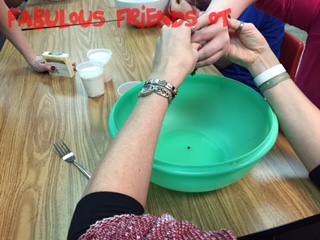Kids love commercial moon sand- or kinetic sand, or cra-z-sand, depending on the brand you buy (and it can be expensive). You can bury things in it and have kids find them, build with it, roll it out, flatten it, stamp it, use cut outs with it, etc. I won't re invent the wheel as far as what you can do with it...here is a link to a previous post to help with that:
http://fabulousfriendsot.blogspot.com/2015/03/play-dough-and-tactile-play.html
You can make your own home made mood sand (and save yourself some money) using the following ingredients:
- Flour
- Canola (or vegetable) Oil
- Food Coloring (although I would suggest paste vs. the liquid)
Ratio of 1:8= 1 cup oil for 8 cups flour (2 cups flour and 1/4 cup oil for a smaller batch)
Put oil in a large bowl, and add food coloring (at least 12+ drops, or use paste until you get a nice, dark color).
The oil and the food coloring will not mix well, but it still should be okay- again, paste would likely be better for a richer color.
Home made soap mud (sometimes called ghost mud):
You will need:
- bar of ivory soap
- roll of toilet paper
- cup of warm water
Here's the part that kids love:
- have them unroll the toilet paper roll (this can get a little wild)
- put the bar of ivory soap in the microwave for about 1 minute and 20 seconds. Have you ever done this before? If not, it is pretty cool~ this is what happens to the soap:
Prior to putting the bar into the microwave, I let the kids look at the bar of soap, smell it, and feel/hold the bar so that they would see how it had transformed after I took it out of the microwave.
- Once the soap is cool (doesn't take long), have the kids crumble it up into a large container (good bilateral activity), and then add the water. Mix it up.
- Have the kids shred the toilet paper up (another good bilateral activity), and add it to the soap/water mixture.
This can be quite a large chore- this activity is a good group activity for that very reason.
- Mix it all together well, using your hands. This takes some work. Add very small amounts of water as needed (there are different plies of toilet paper, so depending on what brand or size you use, you may need to add more water).













